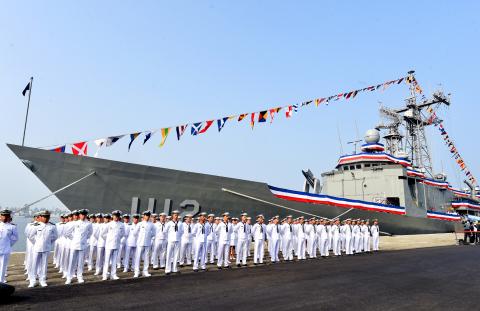President Tsai Ing-wen (蔡英文) yesterday vowed that the nation would not “concede one step” in defending itself as she inaugurated two frigates purchased from the US.
The two Perry-class guided missile frigates were commissioned in a ceremony at the Zuoying naval base in Kaohsiung.
Built in the 1980s, the frigates were originally named USS Taylor and USS Gary, and were part of a US$1.8 billion arms deal to Taiwan announced in 2015 under then-US president Barack Obama. They have been renamed Ming Chuan (銘傳) and Feng Chia (逢甲).

Photo: Chien Jung-fong, Taipei Times
They have “high mobility, high sea resistance and low noise,” and are fitted with the SQR-19 sonar system currently used by the US Navy, the Republic of China Navy said.
The ships are to patrol the Taiwan Strait, it added.
Navy Chief of Staff Vice Admiral Lee Tsung-hsiao (李宗孝) had previously said that the warships’ anti-submarine capabilities are more advanced than the nation’s eight Cheng Kung-class frigates and could have a “deterrent effect” against Chinese submarines.

Photo: Chien Jung-fong, Taipei Times
“We want to send a clear and firm message from Taiwanese to the international community that we will not concede one step in defending ... Taiwan and protecting our free and democratic way of life,” Tsai said after inspecting the ships.
Beijing’s “military actions in the region not only attempt to weaken Taiwan’s sovereignty, but also damage regional peace and stability,” Tsai said.
She highlighted the unconventional “three warfare” threats from the Chinese People’s Liberation Army: psychological, public opinion and legal warfare.
The global security situation is undergoing rapid change and the nation is facing a new array of security challenges, including China’s military exercises near the nation’s periphery, she said.
Beijing deploys conventional and unconventional military methods against Taiwan, including leveraging information technology, the Internet and new media to flood Taiwan with disinformation, she said.
Incessant cyberattacks on the nation’s government and enterprises are a national security threat that Taiwan must confront by self-strengthening — its unchanging principle to protect its place in the world, she said.
“It is my solemn hope that the armed forces will follow three noes: no forgetting the mission to defend Taiwan, no giving up on safeguarding regional peace and stability, and no forgetting the threat of foreign forces,” she said.
The American Institute in Taiwan (AIT) in a news release said that the sale of the warships contributes to the military balance in the Indo-Pacific region.
“This sale is consistent with US commitments under the Taiwan Relations Act to provide military articles that support Taiwan’s self-defense,” the institute said.
The frigates “will improve Taiwan’s capability in current and future defensive efforts, and further Taiwan’s continuing work to modernize its armed forces,” it said.
The AIT said it sent representatives to yesterday’s ceremony, including AIT Kaohsiung head Matthew O’Connor and members of the AIT team “to signify our enduring support to Taiwan’s defense under the provisions of the Taiwan Relations Act of 1979.”

The US government has signed defense cooperation agreements with Japan and the Philippines to boost the deterrence capabilities of countries in the first island chain, a report by the National Security Bureau (NSB) showed. The main countries on the first island chain include the two nations and Taiwan. The bureau is to present the report at a meeting of the legislature’s Foreign Affairs and National Defense Committee tomorrow. The US military has deployed Typhon missile systems to Japan’s Yamaguchi Prefecture and Zambales province in the Philippines during their joint military exercises. It has also installed NMESIS anti-ship systems in Japan’s Okinawa

‘WIN-WIN’: The Philippines, and central and eastern European countries are important potential drone cooperation partners, Minister of Foreign Affairs Lin Chia-lung said Minister of Foreign Affairs Lin Chia-lung (林佳龍) in an interview published yesterday confirmed that there are joint ventures between Taiwan and Poland in the drone industry. Lin made the remark in an exclusive interview with the Chinese-language Liberty Times (the Taipei Times’ sister paper). The government-backed Taiwan Excellence Drone International Business Opportunities Alliance and the Polish Chamber of Unmanned Systems on Wednesday last week signed a memorandum of understanding in Poland to develop a “non-China” supply chain for drones and work together on key technologies. Asked if Taiwan prioritized Poland among central and eastern European countries in drone collaboration, Lin

NO CONFIDENCE MOTION? The premier said that being toppled by the legislature for defending the Constitution would be a democratic badge of honor for him Premier Cho Jung-tai (卓榮泰) yesterday announced that the Cabinet would not countersign the amendments to the local revenue-sharing law passed by the Legislative Yuan last month. Cho said the decision not to countersign the amendments to the Act Governing the Allocation of Government Revenues and Expenditures (財政收支劃分法) was made in accordance with the Constitution. “The decision aims to safeguard our Constitution,” he said. The Constitution stipulates the president shall, in accordance with law, promulgate laws and issue mandates with the countersignature of the head of the Executive Yuan, or with the countersignatures of both the head of the Executive Yuan and ministers or

CABINET APPROVAL: People seeking assisted reproduction must be assessed to determine whether they would be adequate parents, the planned changes say Proposed amendments to the Assisted Reproduction Act (人工生殖法) advanced yesterday by the Executive Yuan would grant married lesbian couples and single women access to legal assisted reproductive services. The proposed revisions are “based on the fundamental principle of respecting women’s reproductive autonomy,” Cabinet spokesperson Michelle Lee (李慧芝) quoted Vice Premier Cheng Li-chiun (鄭麗君), who presided over a Cabinet meeting earlier yesterday, as saying at the briefing. The draft amendment would be submitted to the legislature for review. The Ministry of Health and Welfare, which proposed the amendments, said that experts on children’s rights, gender equality, law and medicine attended cross-disciplinary meetings, adding that